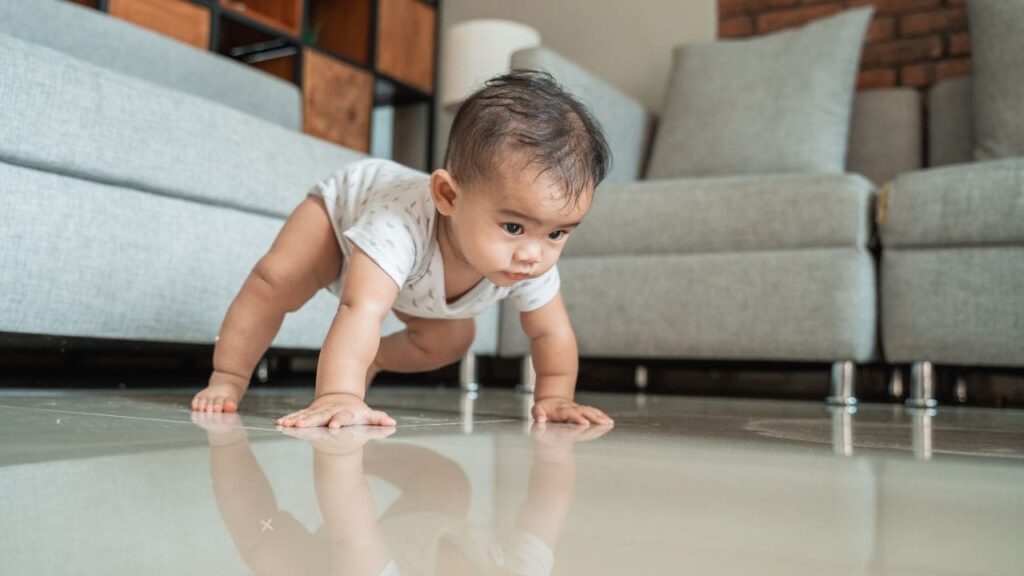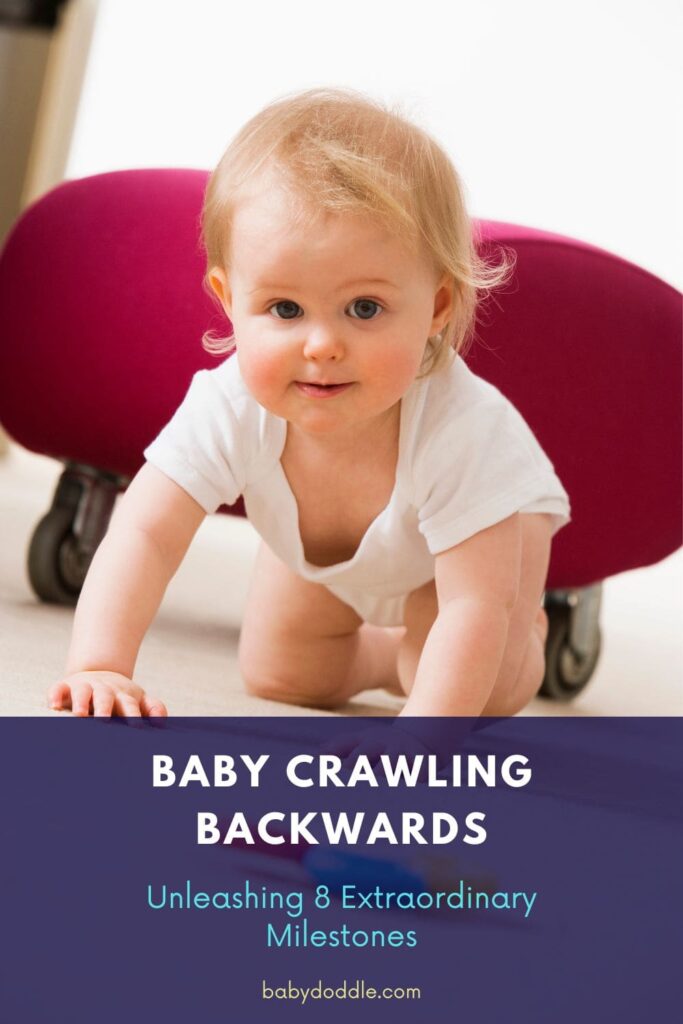As a parent, there’s nothing quite as captivating as watching your little one’s developmental journey unfold before your eyes. From those first wobbly steps to the moment they utter their first word, every milestone is a testament to their remarkable growth and progress. However, one particular phase often leaves parents scratching their heads in bewilderment – the phase where their baby starts crawling backwards.
If you’ve found yourself in this situation, rest assured, you’re not alone. Countless parents have witnessed their little ones seemingly defy the laws of forward motion, opting instead to embrace the art of backward crawling. But fear not, for this seemingly unconventional movement is not only perfectly normal but also a significant milestone that unveils a series of extraordinary developmental achievements.
In this comprehensive guide, we’ll delve into the intriguing phenomenon of babies crawling backwards, unveiling the remarkable milestones they unlock along the way. So, buckle up and get ready to embark on a journey that will leave you in awe of your little one’s incredible capabilities.
Why is Your Baby Crawling Backwards?
Before we dive into the extraordinary milestones associated with backward crawling, let’s first address the burning question: why do babies crawl backwards in the first place? The answer lies in the intricate interplay between their developing motor skills, muscle coordination, and cognitive processes.
You see, when babies first attempt to crawl, their movements are often uncoordinated and sporadic. They may try to propel themselves forward but end up inadvertently moving backwards. This seemingly counterintuitive movement is a result of their still-developing muscle control and coordination.
As they continue to explore their newfound mobility, babies may find that crawling backwards is easier than crawling forward, at least initially. This is because the muscles required for backward crawling, such as those in the back and shoulders, tend to develop slightly earlier than the muscles needed for forward crawling.

Additionally, cognitive processes play a role in this behavior. Babies are naturally curious and driven to explore their surroundings. When they discover that they can move by crawling backwards, they instinctively embrace this newfound ability, regardless of the direction they’re heading.
The Art of Backward Crawling: Understanding the Mechanics
While it may seem like a simple movement, backward crawling is a testament to your baby’s rapidly developing motor skills and cognitive abilities. This unique movement requires a level of coordination that involves a symphony of muscle groups working in harmony.
As your baby crawls backwards, they engage their core muscles, back, shoulders, and arms to generate the necessary propulsion. Their hands and arms provide the primary thrust, while their legs and knees act as stabilizers, helping to maintain balance and control.
But it’s not just about physical coordination; backward crawling also involves cognitive processes. Your baby must constantly assess their surroundings, plan their movements, and adjust their trajectory as they navigate obstacles or navigate towards their desired destination.
Milestone 1: Strengthening Core Muscles and Balance
One of the extraordinary milestones associated with backward crawling is the development of core strength and improved balance. As your baby engages their abdominal muscles, back, and shoulders to propel themselves backwards, they are inadvertently strengthening these crucial muscle groups.
A strong core is essential for a myriad of future physical milestones, such as sitting upright, standing, and eventually walking. By crawling backwards, your baby is laying the foundation for these future achievements, developing the stability and coordination needed to navigate the world around them with confidence.
Moreover, backward crawling requires your baby to maintain their balance as they move, further refining their proprioceptive abilities (the awareness of their body’s position in space). This heightened sense of balance will serve them well as they progress to more complex physical tasks, such as climbing, running, and eventually participating in sports or other physical activities.
Next-Step Advice: Encourage your baby’s core strength and balance development by providing a safe, open space for them to crawl freely. Consider placing a few low obstacles, such as cushions or soft toys, in their path to challenge their maneuvering abilities. Additionally, engaging in tummy time activities can further strengthen their core muscles, preparing them for the next phase of their physical development.
Milestone 2: Enhancing Spatial Awareness and Problem-Solving Skills
As your baby navigates their environment while crawling backwards, they are inadvertently developing a heightened sense of spatial awareness and problem-solving abilities. Unlike crawling forward, where their line of sight is clear, backward crawling requires your baby to constantly assess their surroundings from a different perspective.
They must process visual cues, such as the position of furniture, toys, or obstacles, and adapt their movements accordingly. This cognitive exercise not only enhances their spatial awareness but also fosters their ability to analyze situations, identify potential challenges, and devise creative solutions to overcome them.
For example, if your baby encounters a low-lying obstacle while crawling backwards, they may need to adjust their trajectory, navigate around it, or find an alternative route. This problem-solving process engages their critical thinking skills, laying the foundation for future academic and real-life challenges they may face.

Next-Step Advice: To further enhance your baby’s spatial awareness and problem-solving skills, consider creating a safe, stimulating environment with various obstacles and pathways. Arrange toys, cushions, or lightweight objects in different configurations, encouraging your baby to navigate their way through the makeshift obstacle course. Remember to supervise and provide gentle guidance when necessary, but also allow your baby the freedom to explore and find their own solutions.
Milestone 3: Boosting Cognitive Development and Memory
Contrary to popular belief, crawling backwards is not just a physical feat; it also plays a crucial role in cognitive development and memory formation. As your baby engages in this unique movement, they are inadvertently stimulating various regions of their brain, fostering neural connections and enhancing their overall cognitive abilities.
The act of crawling backwards requires your baby to process various sensory inputs, such as visual cues, spatial awareness, and proprioceptive information (the awareness of their body’s position in space). This multisensory integration activates different areas of the brain, strengthening neural pathways and promoting cognitive development.
Furthermore, as your baby navigates their environment while crawling backwards, they are creating spatial maps and forming memories of their surroundings. This memory formation process is essential for future learning and skill development, as it lays the foundation for recognizing patterns, recalling information, and building upon existing knowledge.
Next-Step Advice: To support your baby’s cognitive development and memory formation, consider incorporating sensory-rich activities into their playtime. Introduce various textures, sounds, and visual stimuli to engage their senses and promote multisensory integration. Additionally, narrating your baby’s movements and experiences as they crawl backwards can reinforce memory formation and language development.
How to Help Your Baby Crawl Forward
While backward crawling is a normal and expected phase in your baby’s development, it’s essential to encourage and support their progression to forward crawling. This transition not only prepares them for future milestones like walking but also promotes further development in various areas.
Here are some tips and techniques to help your baby make the transition to forward crawling:
- Tummy Time: Engage in regular tummy time sessions to strengthen your baby’s neck, back, and arm muscles, which are essential for forward crawling.
- Use Toys and Temptations: Place your baby’s favorite toys or treats just out of reach in front of them, encouraging them to crawl forward to retrieve the desired object.
- Incorporate Resistance and Support: When you notice your baby attempting to move forward, gently place your hand behind their feet to provide resistance, encouraging them to push forward. Alternatively, support their hips or torso to help them feel more stable in the forward crawling position, gradually reducing support as they gain confidence.
- Lead by Example: Demonstrate forward crawling movements yourself, allowing your baby to observe and mimic your actions.
- Provide Encouragement and Praise: Celebrate every effort and achievement, no matter how small, to reinforce positive behavior and boost your baby’s confidence.
Remember, every baby progresses at their own pace, so be patient and allow your little one to develop at their own unique rhythm. If you have any concerns about your baby’s developmental milestones, don’t hesitate to consult with your pediatrician.
Milestone 4: Fostering Independence and Exploration
As your baby embraces the art of backward crawling, they are also unlocking a newfound sense of independence and curiosity. This milestone is a pivotal moment in their journey towards self-discovery and exploration of the world around them.
With their newfound mobility, your baby can now venture beyond the confines of their designated play area, exploring new territories and discovering a wealth of stimuli waiting to be discovered. From the textures of different surfaces to the shapes and colors of objects, every crawling expedition is an opportunity for sensory exploration and learning.
This sense of independence not only fosters your baby’s confidence but also encourages them to take risks, push boundaries, and satisfy their innate curiosity about the world around them. As they navigate their environment while crawling backwards, they are developing a sense of autonomy and decision-making skills that will serve them well throughout their lives.
Moreover, the act of exploration is a critical component of cognitive development. As your baby interacts with new objects, textures, and environments, they are constantly forming neural connections and building upon their existing knowledge base. This hands-on learning experience is invaluable, as it lays the foundation for future academic and social success.
Next-Step Advice: Embrace your baby’s newfound independence and create a safe, stimulating environment for them to explore. Baby-proof your home by removing potential hazards, securing furniture, and creating designated play areas with a variety of toys and objects to captivate their curiosity. Remember to supervise their explorations, but also allow them the freedom to discover and learn at their own pace.
Milestone 5: Improving Coordination and Bilateral Integration
One of the extraordinary milestones associated with backward crawling is the improvement of coordination and bilateral integration. This unique movement requires the synchronization of both sides of the body, promoting the development of cross-body coordination and setting the stage for future skills.
As your baby crawls backwards, they are engaging their arms, legs, and core muscles in a coordinated fashion, with each limb playing a distinct role in propelling and stabilizing their movement. This cross-body coordination is essential for a variety of future activities, such as handwriting, throwing, and catching.
Additionally, backward crawling fosters bilateral integration, which refers to the ability of the two hemispheres of the brain to communicate and work together effectively. This integration is crucial for tasks that require the simultaneous use of both sides of the body, such as riding a bicycle or playing a musical instrument.
By engaging in backward crawling, your baby is laying the groundwork for these essential skills, developing the neural pathways and muscle memory necessary for future success.
Next-Step Advice: To further promote coordination and bilateral integration, consider incorporating activities that encourage cross-body movements. For example, gently guiding your baby’s hands and feet to crawl in opposite directions or engaging in interactive games that involve reaching, grasping, and transferring objects from one hand to the other.
Milestone 6: Developing Perseverance and Resilience
As any parent can attest, raising a child is not without its challenges, and the journey of backward crawling is no exception. However, this milestone presents a unique opportunity for your baby to develop essential qualities like perseverance and resilience.
Crawling backwards often involves navigating obstacles, overcoming challenges, and encountering setbacks. Whether it’s maneuvering around furniture, traversing different surfaces, or simply maintaining balance, your baby will inevitably face situations that require determination and perseverance.
Through these experiences, your baby is learning valuable lessons about resilience – the ability to bounce back from adversity and approach challenges with a positive mindset. They are developing a growth mindset, understanding that progress and mastery come through effort, persistence, and a willingness to learn from mistakes.
These qualities are not only invaluable for future academic and professional pursuits but also for navigating the complexities of life itself. By fostering perseverance and resilience from an early age, you are equipping your child with the tools necessary to overcome obstacles, adapt to change, and ultimately thrive in any situation.

Next-Step Advice: Celebrate your baby’s efforts and progress, no matter how small. Acknowledge their perseverance in the face of challenges, and praise their resilience when they encounter setbacks. Create a supportive and encouraging environment that fosters a growth mindset, reinforcing the idea that challenges are opportunities for learning and growth.
Milestone 7: Enhancing Social and Emotional Development
While the physical and cognitive benefits of backward crawling are undeniable, this milestone also plays a crucial role in your baby’s social and emotional development. As your little one navigates their environment while crawling backwards, they are inadvertently enhancing their ability to interact, communicate, and form meaningful connections with those around them.
One of the key ways backward crawling contributes to social development is through the promotion of eye contact and nonverbal communication. As your baby moves backward, they are constantly scanning their surroundings, making eye contact with caregivers and others in their vicinity. This direct eye contact not only strengthens the bond between you and your baby but also lays the foundation for effective nonverbal communication skills.
Additionally, backward crawling encourages communication and social interaction. As your baby explores their surroundings, they may encounter new objects, people, or situations that pique their curiosity or elicit a response. This natural curiosity often prompts them to vocalize or gesture, initiating a dialogue with those around them and fostering their language and social skills.
Moreover, the sense of accomplishment and pride that comes with mastering backward crawling can have a profound impact on your baby’s emotional development. As they overcome challenges and achieve new milestones, they are building self-confidence and a positive self-image, essential components of healthy emotional growth.
Next-Step Advice: Engage with your baby during their backward crawling adventures. Narrate their experiences, respond to their vocalizations, and celebrate their achievements. This not only reinforces their social and language skills but also fosters a strong emotional connection between you and your little one.
Safety and Supervision during Crawling Practice
As your baby embarks on their crawling adventures, it’s crucial to ensure a safe and secure environment for them to practice and explore. While backward crawling is a natural and expected phase, it also presents potential hazards if proper precautions are not taken.
Here are some essential safety considerations to keep in mind:
- Baby-Proofing: Thoroughly baby-proof your home by securing furniture, covering sharp edges, and removing potential hazards from your baby’s reach. Install safety gates at staircases and block off rooms or areas that you’d prefer your baby to avoid.
- Supervision: Never leave your baby unattended during crawling practice. Maintain constant supervision to ensure their safety and provide guidance or assistance when needed.
- Safe Play Areas: Designate specific areas for your baby’s crawling practice, ensuring that these spaces are free from potential hazards and have a soft, padded surface to cushion any falls or tumbles.
- Recognize Signs of Fatigue: Be mindful of your baby’s energy levels and signs of fatigue. If they appear tired, overstimulated, or distressed, it’s best to take a break and allow them to rest.
- Secure Loose Objects: Remove any small, loose objects that your baby could potentially ingest or choke on during their crawling explorations.
- Electrical Safety: Ensure that electrical cords and outlets are properly secured and out of your baby’s reach to prevent potential electrocution hazards.
By following these safety guidelines and remaining vigilant during your baby’s crawling practice sessions, you can create a secure and nurturing environment for them to explore, learn, and achieve their developmental milestones.
Next-Step Advice: Conduct regular safety checks around your home, identifying and addressing potential hazards before they become a concern. Additionally, consider enrolling in a baby-proofing course or consulting with a professional to ensure you’ve covered all bases in creating a safe and secure environment for your little explorer.
| Safety Measure | Description |
| Baby-Proofing | Secure furniture, cover sharp edges, and remove potential hazards. |
| Install Safety Gates | Block off staircases and rooms you want to restrict access to. |
| Designated Play Areas | Create safe, padded spaces for crawling practice. |
| Secure Loose Objects | Remove small objects that could be a choking hazard. |
| Electrical Safety | Secure cords and outlets to prevent electrocution hazards. |
| Supervision | Maintain constant supervision during crawling practice. |
Milestone 8: Preparing for Future Milestones
While backward crawling may seem like a standalone achievement, it is, in fact, a crucial stepping stone that prepares your baby for a multitude of future milestones. This unique movement lays the foundation for more complex physical tasks, cognitive development, and overall growth.
From a physical standpoint, backward crawling helps strengthen and coordinate the muscles necessary for future movements like walking, running, climbing, and even participating in sports or physical activities. The core strength, balance, and coordination developed during this phase will serve as a solid base for your baby’s ongoing motor skill development.
Moreover, the cognitive benefits of backward crawling, such as enhanced spatial awareness, problem-solving abilities, and memory formation, will contribute significantly to your baby’s future academic and intellectual pursuits. These skills will aid in their ability to process information, reason logically, and tackle complex challenges with confidence and creativity.
Additionally, the social and emotional milestones achieved through backward crawling, including improved communication, self-confidence, and resilience, will play a crucial role in your baby’s overall well-being and success in various aspects of life.
By embracing and celebrating this unique phase of development, you are not only nurturing your baby’s current growth but also setting the stage for their future accomplishments and personal growth.
Next-Step Advice: Continue to provide a stimulating and supportive environment for your baby’s ongoing development. Introduce age-appropriate activities and toys that challenge their physical, cognitive, and social skills, building upon the foundations laid during the backward crawling phase.
| Crawling Stage | Approximate Age Range | Description |
| Belly Crawling | 6-8 months | Baby drags their body across the floor using arms and legs. |
| Crawling on All Fours | 8-10 months | Baby lifts their belly off the ground and moves using hands and knees. |
| Backward Crawling | 9-12 months | Baby masters crawling backward before moving forward. |
| Forward Crawling | 10-14 months | Baby learns to propel themselves forward, setting the stage for walking. |
Conclusion
As we’ve explored throughout this comprehensive guide, babies crawling backwards is not just a quirky behavior but a remarkable developmental milestone that unlocks a wealth of extraordinary achievements. From strengthening core muscles and enhancing spatial awareness to fostering independence, improving coordination, and preparing for future milestones, this unique movement plays a pivotal role in your little one’s growth and development.
So, the next time you witness your baby crawling backwards, take a moment to marvel at the incredible journey they are embarking on. Celebrate their determination, resilience, and curiosity, for these qualities will serve them well as they continue to navigate the world around them.
Remember, every child is unique, and their developmental journey may unfold differently. Embrace the milestones, both conventional and unconventional, and cherish the wonder and awe that comes with witnessing your baby’s extraordinary growth.
As parents, our role is to provide a nurturing, supportive, and safe environment for our little ones to explore, learn, and thrive. By understanding the significance of milestones like backward crawling, we can better appreciate the incredible capabilities of our children and the boundless potential that lies within them.
So, let’s celebrate this extraordinary phase, embrace the challenges and triumphs that come with it, and look forward to the countless milestones yet to come. For in the world of child development, every step, every crawl, and every achievement is a testament to the incredible journey we are privileged to witness and cherish.
FAQ – Baby Crawling Backwards
Does Asymmetrical Crawling Mean Autism?
No, asymmetrical crawling (crawling with one side of the body leading or favoring one side) is not necessarily an indicator of autism. While some children with autism may exhibit asymmetrical crawling patterns, this behavior can also occur in typically developing children. Every child is unique, and their developmental journey may involve different patterns and preferences.
What Are the Crawling Stages?
Crawling is a progressive process that typically follows these stages:
- Belly Crawling: Your baby drags their body across the floor using their arms and legs.
- Crawling on All Fours: Your baby begins to lift their belly off the ground and move using their hands and knees.
- Backward Crawling: As discussed, many babies master backward crawling before moving forward.
- Forward Crawling: Finally, your baby learns to propel themselves forward, setting the stage for walking.
Remember, these stages are general guidelines, and each child may progress differently.
Are There Any Developmental Concerns with Backward Crawling?
No, backward crawling is a perfectly normal and expected phase in a baby’s development. However, if your baby exhibits any concerning behaviors, such as consistently favoring one side, avoiding weight-bearing on a particular limb, or showing signs of discomfort during crawling, it’s best to consult with your pediatrician for a proper evaluation.
Can Babies Still Learn to Walk Normally If They Crawl Backward?
Absolutely! Backward crawling is just a temporary phase, and it does not hinder a baby’s ability to learn to walk. In fact, the skills developed during this stage, such as core strength, balance, and coordination, are essential for mastering the art of walking.
Is There Any Difference in Cognitive Development Between Babies Who Crawl Backward and Forward?
No, there is no significant difference in cognitive development between babies who crawl backward and those who crawl forward. The cognitive benefits associated with crawling, such as enhanced spatial awareness, problem-solving skills, and memory formation, are present regardless of the direction in which the baby crawls.
Remember, every child is unique, and their developmental journey may involve different patterns and preferences. If you have any specific concerns or questions, it’s always best to consult with your pediatrician or a child development specialist for professional guidance.












